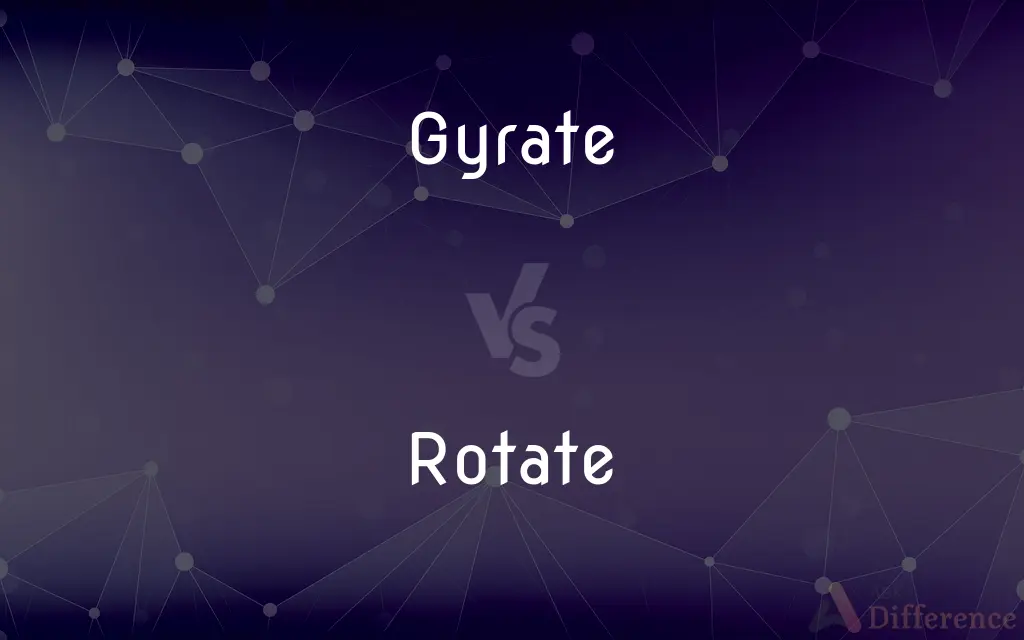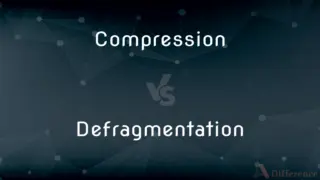Gyrate vs. Rotate — What's the Difference?
By Fiza Rafique & Urooj Arif — Updated on May 8, 2024
Gyrate means to move in a rapid, circular or spiral motion, often erratically or with a wobble, while rotate refers to a smooth, systematic spinning movement around an axis or center point.

Difference Between Gyrate and Rotate
Table of Contents
ADVERTISEMENT
Key Differences
Gyrating involves a swift and often erratic circular motion, which can include a wobbling or spiraling effect, suggesting a more dynamic and sometimes chaotic movement. In contrast, rotating is characterized by a steady, uniform motion around a specific axis, offering a more predictable and controlled movement.
When something gyrates, it may not have a fixed axis, and its movement can seem spontaneous and vigorous, like a dancer spinning energetically in different patterns. On the other hand, rotation implies a fixed rotational path, like the Earth turning around its axis, which is consistent and measurable.
Gyration is commonly used in contexts such as dance or molecular movement, where actions are lively and can change direction or pattern unpredictably. Conversely, rotation is a term often applied in scientific contexts, like astronomy or mechanics, where precision and regularity are key.
The erratic nature of gyration can imply excitement or instability, making it suitable for describing dynamic systems or behaviors. Rotation, however, conveys stability and regularity, essential in describing planetary movements or machinery.
In practical applications, devices like gyroscopes exhibit properties of both gyrating and rotating, as they maintain orientation due to the conservation of angular momentum, illustrating a controlled yet complex movement.
ADVERTISEMENT
Comparison Chart
Type of Movement
Circular or spiral, erratic
Circular, uniform
Axis
May not have a fixed axis
Has a fixed axis
Contexts
Dance, molecular dynamics
Astronomy, mechanics
Impression
Dynamic, potentially chaotic
Stable, predictable
Directionality
Can change direction suddenly
Maintains a consistent direction
Compare with Definitions
Gyrate
Can imply a lack of control or predictability.
The machine began to gyrate uncontrollably due to a malfunction.
Rotate
Implies a controlled, systematic movement.
The chef rotated the skewers to ensure the meat cooked evenly.
Gyrate
Often used to describe energetic or lively motion.
The children gyrated wildly during the lively game.
Rotate
To turn around an axis or center point.
The Earth rotates on its axis once every 24 hours.
Gyrate
To move or cause to move in a spiral or circular course.
The particles in the solution gyrated when stirred.
Rotate
Can involve repeated or continuous motion.
The security camera rotates to monitor the entire area.
Gyrate
Associated with vibrancy and vigor.
The festival crowd gyrated to the rhythm of the drums.
Rotate
Commonly used in mechanical and scientific contexts.
The gears rotate smoothly in the new engine.
Gyrate
To spin around quickly and irregularly.
The dancer gyrated across the floor to the fast-paced music.
Rotate
Describes the action of moving in a circle.
He rotated the wheel with precision.
Gyrate
Move or cause to move rapidly in a circle or spiral
The dog yelped frenetically, wildly gyrating her tail
Rotate
To turn around on an axis or center.
Gyrate
To revolve around a fixed point or axis.
Rotate
To proceed in sequence; take turns or alternate
Interns will rotate through the various departments.
Gyrate
To move in a spiral or spirallike course.
Rotate
To cause to turn on an axis or center.
Gyrate
To oscillate or vary, especially in a repetitious pattern
Stock prices gyrated around last week's high.
Rotate
To plant or grow (crops) in a fixed order of succession.
Gyrate
In rings; coiled or convoluted.
Rotate
To cause to alternate or proceed in sequence
The coach rotates her players frequently near the end of the game.
Gyrate
(intransitive) To revolve round a central point; to move spirally about an axis, as a tornado.
Rotate
Having radiating parts; wheel-shaped.
Gyrate
(biology) Having coils or convolutions.
Rotate
(intransitive) To spin, turn, or revolve.
He rotated in his chair to face me.
The earth rotates.
Gyrate
Winding or coiled round; curved into a circle; taking a circular course.
Rotate
(intransitive) To advance through a sequence; to take turns.
The nurses' shifts rotate each week.
Gyrate
To revolve round a central point; to move spirally about an axis, as a tornado; to revolve.
Rotate
To lift the nose during takeoff, just prior to liftoff.
The aircraft rotates at sixty knots.
Gyrate
To wind or move in a spiral course;
The muscles and nerves of his fine drawn body were coiling for action
Black smoke coiling up into the sky
The young people gyrated on the dance floor
Rotate
(transitive) To spin, turn, or revolve something.
Rotate the dial to the left.
Gyrate
Revolve quickly and repeatedly around one's own axis;
The dervishes whirl around and around without getting dizzy
Rotate
(transitive) To advance something through a sequence; to allocate or deploy in turns.
Rotate
(transitive) To replace older materials or to place older materials in front of newer ones so that older ones get used first.
The supermarket rotates the stock daily so that old foods don't sit around.
Rotate
(transitive) To grow or plant (crops) in a certain order.
Rotate
Having the parts spreading out like a wheel; wheel-shaped.
A rotate spicule or scale; a rotate corolla
Rotate
Having the parts spreading out like a wheel; wheel-shaped; as, a rotate spicule or scale; a rotate corolla, i.e., a monopetalous corolla with a flattish border, and no tube or a very short one.
Rotate
To turn, as a wheel, round an axis; to revolve.
Rotate
To perform any act, function, or operation in turn, to hold office in turn; as, to rotate in office.
Rotate
To cause to turn round or revolve, as a wheel around an axle.
Rotate
To cause to succeed in turn; esp., to cause to succeed some one, or to be succeeded by some one, in office.
Rotate
Turn on or around an axis or a center;
The Earth revolves around the Sun
The lamb roast rotates on a spit over the fire
Rotate
Exchange on a regular basis;
We rotate the lead soprano every night
Rotate
Cause to turn on an axis or center;
Rotate the handle
Rotate
Perform a job or duty on a rotating basis;
Interns have to rotate for a few months
Rotate
Turn outward;
These birds can splay out their toes
Ballet dancers can rotate their legs out by 90 degrees
Rotate
Plant or grow in a fixed cyclic order of succession;
We rotate the crops so as to maximize the use of the soil
Common Curiosities
How do gyration and rotation differ in physics?
In physics, gyration can involve complex, variable axis movements, while rotation specifically involves movement around a fixed axis.
What is an example of rotation in daily life?
Common examples include a wheel rotating on its axle or a rotating door.
What is the main difference between gyrate and rotate?
Gyrate refers to moving in a lively, often erratic circular motion, while rotate means turning around a central axis in a controlled, uniform manner.
What types of objects or subjects commonly gyrate?
Subjects like dancers, particles in liquids, or children playing might gyrate.
Is gyration ever used in a technical or scientific context?
Yes, gyration is used in areas like chemistry and physics to describe molecular or particle motion.
What does it mean when a planet rotates?
It refers to the planet spinning around its axis, which dictates the length of its day.
Can both terms be used interchangeably?
Due to their distinct connotations and contexts, gyrate and rotate are not typically interchangeable.
Why is rotation important in machinery?
Rotation is crucial for the consistent and efficient function of many mechanical systems, from simple wheels to complex industrial machines.
Can humans gyrate naturally?
Yes, human movement in dance or certain exercises can involve gyrating motions.
Does gyration imply instability?
Gyration can suggest a lack of stability, especially if the motion is erratic or uncontrollable.
Share Your Discovery

Previous Comparison
Compression vs. Defragmentation
Next Comparison
Leading vs. ControllingAuthor Spotlight
Written by
Fiza RafiqueFiza Rafique is a skilled content writer at AskDifference.com, where she meticulously refines and enhances written pieces. Drawing from her vast editorial expertise, Fiza ensures clarity, accuracy, and precision in every article. Passionate about language, she continually seeks to elevate the quality of content for readers worldwide.
Co-written by
Urooj ArifUrooj is a skilled content writer at Ask Difference, known for her exceptional ability to simplify complex topics into engaging and informative content. With a passion for research and a flair for clear, concise writing, she consistently delivers articles that resonate with our diverse audience.














































